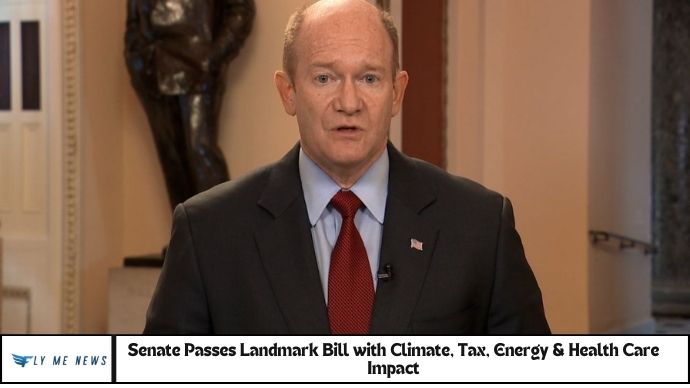Senate Passes Landmark Bill with Climate, Tax, Energy & Health Care Impact The Senate has passed the Inflation Reduction Act, a landmark piece of legislation aimed at transforming U.S. policies on climate change, taxation, and health care. Following intense negotiations among key Democrats, including Sen. Joe Manchin (D-W.Va.) and Senate Majority Leader Chuck Schumer (D-N.Y.), the Act outlines ambitious goals, such as reducing carbon emissions by 40% by 2030, and incorporates elements of the previously stalled Build Back Better Act (BBBA).
This article highlights the key provisions of the Inflation Reduction Act, which is designed to accelerate the transition to clean energy, enforce a 15% minimum tax on corporations, and lower prescription drug costs. The Act provides a variety of grants, loans, and tax credits for both businesses and consumers, impacting sectors ranging from automotive manufacturing to utilities and energy production.
One notable change during negotiations with moderate Democrat Sen. Kyrsten Sinema (D-Ariz.) was the removal of a provision addressing carried interests, which was replaced with a new 1% excise tax on stock buybacks by U.S. public companies.
Senate Democrats, who used the budget reconciliation process to pass the measure, argue that the Act will raise sufficient revenue to offset new investments and reduce the federal deficit over the next decade. The House of Representatives is expected to pass the Act on August 12, 2022.
The Landmark Bill: Key Provisions
The bill passed by the Senate represents an ambitious attempt to tackle critical issues in one comprehensive package. Let’s look at the core components:
Climate Action and Environmental Protections
With climate change posing an ever-growing threat, the bill includes significant investments in renewable energy sources, aiming to drastically cut carbon emissions. Key provisions include:
- Clean energy incentives: Tax credits for individuals and businesses investing in solar, wind, and other renewable energy sources.
- Carbon emissions reduction: Funding for programs to help states and businesses meet ambitious greenhouse gas reduction goals.
- Electric vehicle (EV) expansion: Boosting the adoption of electric vehicles with incentives for consumers and manufacturers.
This move could accelerate the U.S.’s transition to a low-carbon economy and help meet international climate commitments.
Tax Reform: Ensuring Fair Contributions
In a move aimed at reducing inequality, the bill includes tax reforms that target wealthier individuals and large corporations. Key elements include:
- Corporate tax hikes: Increasing the corporate tax rate to ensure businesses pay their fair share.
- Tax relief for the middle class: Expanding tax credits for low- and middle-income households.
- Wealth tax enforcement: Stronger measures to close loopholes and reduce tax evasion among the wealthiest Americans.
These measures are designed to increase government revenue while providing relief to working-class citizens.
Energy Policy: Transitioning to Sustainable Solutions
Energy sustainability is a major focus of the legislation, as the U.S. strives to reduce its reliance on fossil fuels. Among the most important provisions are:
- Renewable energy subsidies: Encouraging the development and deployment of wind, solar, and hydroelectric energy.
- Energy efficiency grants: Providing financial support for businesses and homeowners to make energy-efficient upgrades.
- Grid modernization: Funding for upgrading the national power grid to handle more renewable energy.
These initiatives are critical in promoting energy independence and ensuring long-term sustainability.
Health Care Reform: Expanding Access
With millions of Americans still lacking access to affordable healthcare, this bill includes measures to expand coverage and reduce costs:
- Medicare expansion: Extending coverage to more seniors, with provisions to lower prescription drug prices.
- Affordable Care Act (ACA) subsidies: Increasing subsidies to help individuals afford health insurance through the ACA marketplace.
- Mental health support: Investing in mental health services to meet rising demand and improve public health outcomes.
These changes could improve access to care, reduce health care costs, and ensure that more Americans receive the health services they need.
The Potential Long-Term Effects of the Bill
While the bill’s provisions are extensive, the true impact will unfold over time. Key areas to watch include:
- Economic growth: The bill is expected to stimulate job creation in renewable energy sectors and create economic opportunities for marginalized communities.
- Climate leadership: The U.S. could lead the world in climate action if these policies are fully implemented, potentially inspiring other nations to follow suit.
- Tax fairness: With more equitable tax structures, the government could invest more heavily in public services and infrastructure.
However, challenges remain, including implementation hurdles, political resistance, and the need for ongoing cooperation across different levels of government.
Conclusion
The passage of this landmark bill is a significant step forward in addressing some of the most pressing challenges of our time. By focusing on climate change, tax reform, energy sustainability, and health care, the legislation aims to create a more equitable and sustainable future for all Americans. While there is still work to be done, this bill sets the stage for progress and a more prosperous nation.
FAQs
What is the landmark bill passed by the Senate about?
The bill addresses key issues like climate change, tax reform, energy policy, and health care, aiming to create a more sustainable and equitable future for Americans.
How does this bill address climate change?
The bill provides funding for renewable energy projects, tax credits for green energy adoption, and programs aimed at reducing carbon emissions.
What are the tax reforms included in the bill?
The bill raises corporate taxes, provides relief for middle-income households, and strengthens enforcement of wealth tax regulations.
How will the bill impact energy policy?
It promotes renewable energy sources like wind and solar, increases energy efficiency, and modernizes the national grid to support clean energy.
What health care provisions are included in the bill?
The bill expands Medicare coverage, lowers prescription drug costs, and increases subsidies for the Affordable Care Act to improve access to health care.
What are the long-term effects of this legislation?
The bill is expected to stimulate job growth, position the U.S. as a global climate leader, and create a more equitable tax system.

